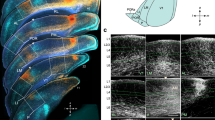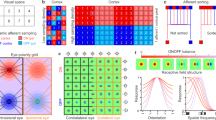Abstract
A hallmark of mammalian brain evolution is the disproportionate increase in neocortical size as compared with subcortical structures1. Because primary visual cortex (V1) is the most thoroughly understood cortical region, the visual system provides an excellent model in which to investigate the evolutionary expansion of neocortex. I have compared the numbers of neurons in the visual thalamus (lateral geniculate nucleus; LGN) and area V1 across primate species. Here I find that the number of V1 neurons increases as the 3/2 power of the number of LGN neurons. As a consequence of this scaling law, the human, for example, uses four times as many V1 neurons per LGN neuron (356) to process visual information as does a tarsier (87). I argue that the 3/2 power relationship is a natural consequence of the organization of V1, together with the requirement that spatial resolution in V1 should parallel the maximum resolution provided by the LGN. The additional observation that thalamus/neocortex follows the same evolutionary scaling law as LGN/V1 may suggest that neocortex generally conforms to the same organizational principle as V1.
This is a preview of subscription content, access via your institution
Access options
Subscribe to this journal
Receive 51 print issues and online access
$199.00 per year
only $3.90 per issue
Buy this article
- Purchase on Springer Link
- Instant access to full article PDF
Prices may be subject to local taxes which are calculated during checkout



Similar content being viewed by others
References
Finlay, B. L. & Darlington, R. B. Linked regularities in the development and evolution of mammalian brains. Science 268, 1578–1584 (1995).
Barton, R. A. & Harvey, P. H. Mosaic evolution of brain structure in mammals. Nature 405, 1055–1058 (2000).
Andrews, T. J., Halpern, S. D. & Purves, D. Correlated size variations in human visual cortex, lateral geniculate nucleus, and optic tract. J. Neurosci. 17, 2859–2868 (1997).
Stephan, H., Frahm, H. D. & Baron, G. New and revised data on volumes and brain structures in insectivores and primates. Folia primatol. 35, 1–29 (1981).
Schein, S. J. & de Monasterio, F. M. Mapping of retinal and geniculate neurons onto striate cortex of macaque. J. Neurosci. 7, 996–1009 (1987).
Ahmad, A. & Spear, P. D. Effects of aging on the size, density, and number of rhesus monkey lateral geniculate neurons. J. Comp. Neurol. 334, 631–643 (1993).
Hubel, D. H. & Wiesel, T. N. Receptive fields and functional architecture of monkey striate cortex. J. Physiol. (Lond.) 195, 215–243 (1968).
Bonhoeffer, T. & Grinvald, A. Iso-orientation domains in cat visual cortex are arranged in pinwheel-like patterns. Nature 353, 429–431 (1991).
Swindale, N. V. How many maps are there in visual cortex? Cereb. Cortex 10, 633–643 (2000).
Issa, N. P., Trepel, C. & Stryker, M. P. Spatial frequency maps in cat visual cortex. J. Neurosci. 20, 8504–8514 (2000).
Frahm, H. D., Stephan, H. & Stephan, M. Comparison of brain structure volumes in Insectivora and Primates. I. Neocortex. J. Hirnforsch. 23, 375–389 (1982).
Rockel, A. J., Hiorns, R. W. & Powell, T. P. The basic uniformity in structure of the neocortex. Brain 103, 221–244 (1980).
Armstrong, E. A quantitative comparison of the hominoid thalamus. IV. Posterior association nuclei—the pulvinar and lateral posterior nucleus. Am. J. Phys. Anthropol. 55, 369–383 (1981).
Armstrong, E. A quantitative comparison of the hominoid thalamus: II. Limbic nuclei anterior principalis and lateralis dorsalis. Am. J. Phys. Anthropol. 52, 43–54 (1980).
Armstrong, E. Quantitative comparison of the hominoid thalamus. I. Specific sensory relay nuclei. Am. J. Phys. Anthropol. 51, 365–382 (1979).
Frahm, H. D., Stephan, H. & Baron, G. Comparison of brain structure volumes in insectivora and primates. V. Area striata (AS). J. Hirnforsch. 25, 537–557 (1984).
Shulz, H.-D. Metrische Untersuchagen an den Schichten des Corpus Geniculatum Laterale tag- und Nachtaktiven Primaten. Thesis, Johann Wolfgang Goethe-Universitaet Frankfurt (1967)).
Fritschy, J. M. & Garey, L. J. Quantitative changes in morphological parameters in the developing visual cortex of the marmoset monkey. Brain Res. 394, 173–888 (1986).
Acknowledgements
Much of the work described here was done at the Santa Fe Institute and the Aspen Center for Physics, and I thank those institutions for their support. I also thank T. Albright, S. Gandhi and I. Brivanlou for comments on an earlier draft.
Author information
Authors and Affiliations
Corresponding author
Rights and permissions
About this article
Cite this article
Stevens, C. An evolutionary scaling law for the primate visual system and its basis in cortical function. Nature 411, 193–195 (2001). https://doi.org/10.1038/35075572
Received:
Accepted:
Issue Date:
DOI: https://doi.org/10.1038/35075572
This article is cited by
-
A theory of cortical map formation in the visual brain
Nature Communications (2022)
-
A unique cellular scaling rule in the avian auditory system
Brain Structure and Function (2016)
-
Faster scaling of visual neurons in cortical areas relative to subcortical structures in non-human primate brains
Brain Structure and Function (2013)
-
Neuronal functional diversity and collective behaviors: a scientific case
Cognitive Processing (2009)
-
Neuronal Functional Diversity and Collective Behaviors
Journal of Biological Physics (2008)
Comments
By submitting a comment you agree to abide by our Terms and Community Guidelines. If you find something abusive or that does not comply with our terms or guidelines please flag it as inappropriate.



